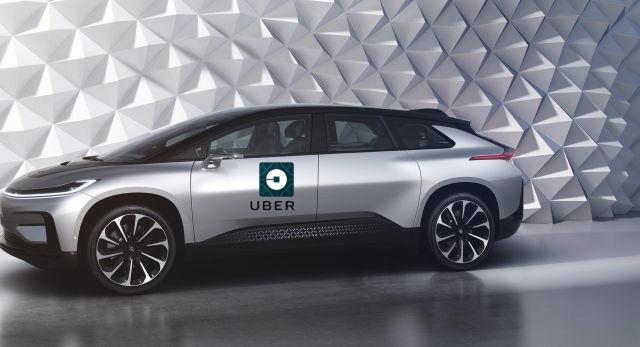Up front, it’s probably necessary to say that I haven’t considered the financial viability of this for either party, or whether their business plans are even sound. But I think it could benefit both of them: Faraday Future and Uber, two troubled companies facing an uncertain future in different ways. should strike a deal to work on autonomous vehicles together.
Photo: FF, Uber
[referenced url=”https://gizmodo.com.au/2017/02/uber-is-doomed/” thumb=”https://i.kinja-img.com/gawker-media/image/upload/t_ku-large/h8zst1hbjlmikxieacmv.png” title=”Uber Is Doomed” excerpt=”Illustration credit. Jim Cooke/Jalopnik If there is one quote that sums up the ethos of Uber, it might be this cut from the company’s firebrand CEO Travis Kalanick. “Stand by your principles and be comfortable with confrontation. So few people are, so when the people with the red tape come, it becomes a negotiation.” But after a month marked by one disaster after another, it’s hard to see how Uber’s defiant, confrontational attitude hasn’t blown up in its face. And those disasters mask one key, critical issue. Uber is doomed because it can’t actually make money.”]
Uber already has a $US300 ($403) million partnership with Volvo, which provided 100 XC90s for the ride-hailing giant’s autonomous driving pilot program in Pittsburgh, and Volvo said it no intention of dropping it anytime soon, despite Uber’s host of problems. Those problems include an ongoing lawsuit with Google over alleged tech theft, a business model that is yet unprofitable, labour challenges and a reputation for general scumbaggery that’s getting harder and harder to wave off.
But the company’s founder Travis Kalanick believes it needs to successfully develop self-driving cars in order to survive. With competitors barreling ahead to produce fully-autonomous cars by next decade, specifically for ride-hailing purposes, Uber needs to act quick. As its high-profile litigation with Google’s self-driving car project has shown, Uber’s way behind in the race. (Uber literally admitted as much.)
Of course, the Google suit over Uber allegedly stealing its autonomous tech designs could derail the ride-hailing giant’s driverless car ambitions sooner rather than later. But I’m just spitballing here.
Though it’s burning through a massive amount of cash, Uber recently told Bloomberg it still has about $US7 ($9) billion of cash on hand, along with $US2.3 ($3) billion of credit that has yet to be tapped. Enter Faraday.
Faraday’s public image has continued to deteriorate even more rapidly than Uber’s, ever since it debuted its flagship vehicle, the FF 91, in January at the CES conference. Faraday has been dealt a stream of litigation, pertaining to everything from the vehicle debut to how it ended up with its website. Construction of the startup’s factory has yet to restart, and plans for a $US1 ($1) billion production facility have shrunk to a proposed “mini-factory” that could — in theory — later be expanded.
And this month it emerged that Faraday’s main financier, Chinese tech conglomerate Le Eco, hasn’t been able to recover from a serious cash crunch. Last week, it announced significant layoffs for its U.S. operations and business plans going forward.
Faraday’s chief financial officer said the layoffs won’t impact the startup’s ambitions, but all isn’t as optimistic as it seems. Bloomberg reported that it now needs to raise $US1 ($1) billion to keep its dream alive. If this funding round is unsuccessful, the FF 91 — a planned 1,050-HP supposed Tesla-killer that might cost something like $US150,000 ($201,565) per vehicle — may never see the light of day.
I can’t think of a startup in the auto world that’s more ripe to handle a new relationship with scandal-plagued Uber. If Uber gave up a $US1 ($1) billion, it’d still have a decent amount of cash left — whether that cash keeps it afloat more than a few years is another story — and Faraday could finish its original plan for the full-size factory and get the FF 91 into production.
Uber’s business model necessitates the use of autonomous vehicles, and with Faraday, it could land exclusive access to a factory that — on paper — may produce upward of 100,000 vehicles per year. Kalanick previously said it’d make a huge investment of the sort; it was reported that he’d be interested in buying 500,000 Teslas if the carmarker had a fully-autonomous vehicle ready by 2020. But there’s a would-be Tesla competitor in the waiting for Kalanick to consider, one that needs the type of cash he has access to.
The one hiccup, probably, is that the capital costs for Uber to purchase a $US150,000 ($201,565) vehicle would probably be too much, so Faraday might need to develop a cheaper base trim for the ride-hailing network.
But with Faraday’s engineers working to develop a fully-autonomous vehicle, it’d give Uber a new revenue stream through the sale of cars, while having a vehicle to bring onto its network.
It’s not bulletproof, but neither is Faraday or Uber.
